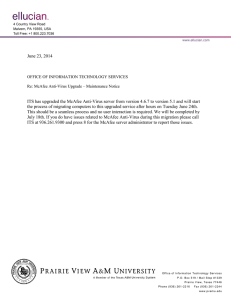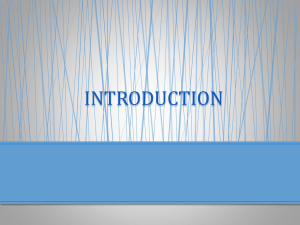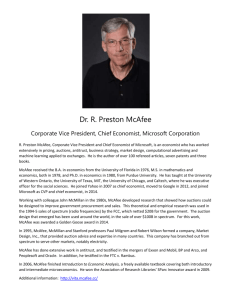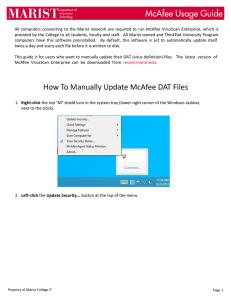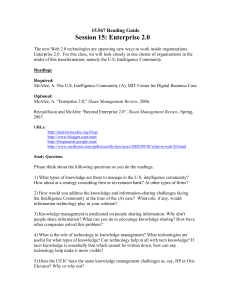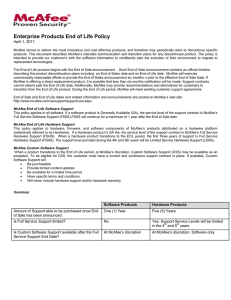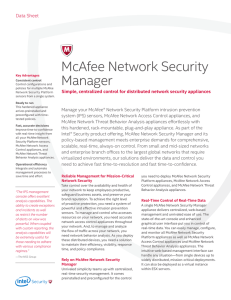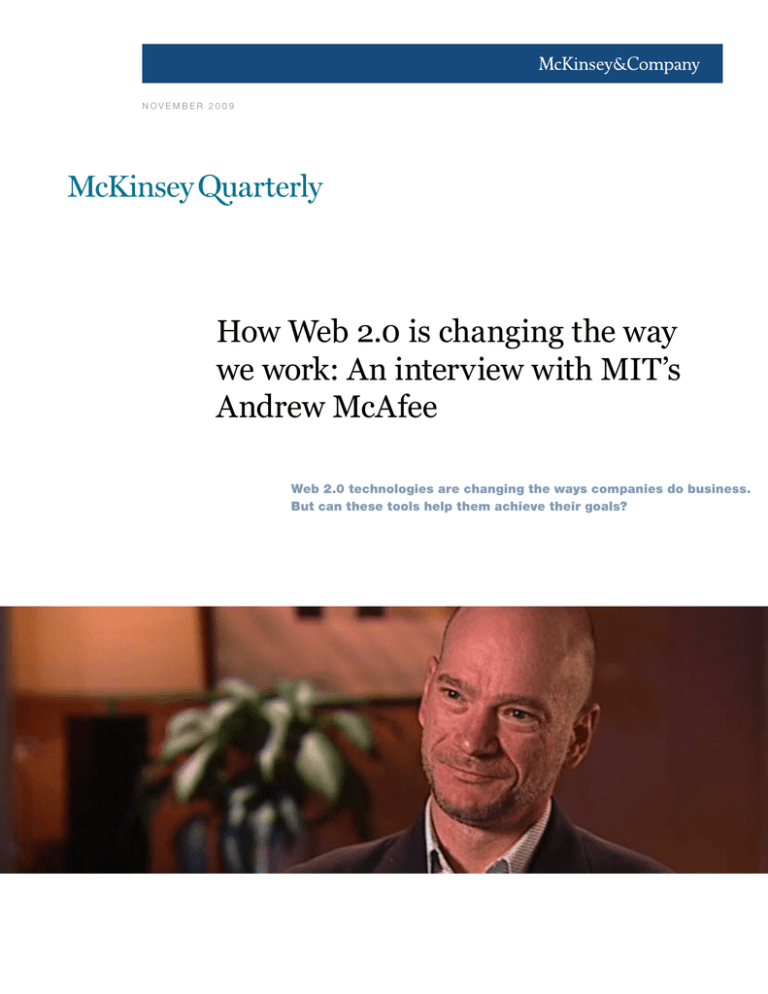
1
NOVEMBER 2009
How Web 2.0 is changing the way
we work: An interview with MIT’s
Andrew McAfee
Web 2.0 technologies are changing the ways companies do business.
But can these tools help them achieve their goals?
2
In recent years, using technology to change the way people work has often meant
painful disruption, as CIOs rolled enterprise software programs through the ranks of
reluctant staffers. Today, employees are more likely to bring in new technologies on their
own—and to do so enthusiastically—through their Web browser, whether it’s starting a
blog, setting up a wiki to share knowledge, or collaborating on documents hosted online.
Andrew McAfee, principal research scientist at the Center for Digital Business at the
MIT Sloan School of Management, has been watching this shift closely. His new book,
Enterprise 2.0: New Collaborative Tools for your Organization’s Toughest Challenges,
explores the ways that leading organizations are bringing Web 2.0 tools inside. McAfee
calls these tools “emergent social software platforms”—highly visible environments with
tools that evolve as people use them—and he is optimistic about their potential to improve
the way we work.
McAfee spoke with McKinsey’s Roger Roberts, a principal in the Silicon Valley office, in
Palo Alto, California, in October 2009.
The Quarterly: How is Enterprise 2.0 changing the way we work?
Andrew McAfee: I think it’s a lot closer to fitting into the way that we actually want
to work. For me, it was really illuminating to understand the early history of Wikipedia.
They always had the goal of creating an online, freely available encyclopedia. But at
first, they thought the way to do that was to define a very precise, seven-step workflow of
people—some of whom would be writers, some who would be editors, some who would be
proofreaders—and to march everyone through that seven-step process.
And they attracted almost no energy with that approach. It was only when they said,
“OK, let’s forget all that. Let’s just set up this weird, new thing called a Wiki, an online
whiteboard where anyone can do whatever they want. And we’re going to let people selfselect into the roles they want to play, the content they want to create, what the articles can
be about. And we’re just going to see what happens.”
And what they saw happen was that people were extremely enthusiastic about coming
together in this way and about doing whatever felt natural to them. What was amazing
to them, and to me as I looked at it, was the quality of the output they got as a result.
Wikipedia is not only huge, it’s actually not bad quality. And this is not something that I
was expecting and that a lot of people were expecting.
The Quarterly: How do you get this started in an organization?
Andrew McAfee: There’s a lot of debate about that question right now. And the
debate is typically between people who advocate [a top-down approach and those who
advocate] almost a purely bottom-up approach—in other words, deploy the tools, stop
3
worrying about what’s going to happen, and get out of the way as the management of the
company and let it percolate up from down below. Or, if you hear about a grassroots effort,
encourage it, support it financially, but, again, get out of the way, let the bottom-up energy
happen.
The other school of thought says that you need some top-down energy, or at least
signaling—that this is appropriate, we want this to happen, this is in line with the goals of
the organization. And the top-down school of thought says if you don’t have those signals
from the top of the organization, people are going to sit on the fence for a long time and
they’re going to wonder if this is a worthwhile use of their time, if it will increase their
human capital in the organization or not. And until they have clear answers to those
questions, they’re going to do nothing, or they’re going to sit on the sidelines.
I have a lot of sympathy for both approaches. I find myself agreeing more with the topdown crowd, though. We know how important it is for management to create culture and
to signal what’s valued inside the organization. These tools are not an exception to that; I
think they’re a great example of it.
One of my initial assumptions was after looking at the Web, you see the phenomenal
growth of things like Facebook and Wikipedia and Flickr and YouTube and all that. I
thought these technologies were essentially so cool that when you dropped them in an
organization, people flocked to them. That was the assumption I carried around in my
research.
I very quickly had that overturned. And in fact what you see is—particularly for longertenured workers, particularly for older workers—this is a big shift for them, changing
their current work practices and moving over to Enterprise 2.0. This is not an overnight
phenomenon at all. And while there are pockets of energy, getting mass adoption remains
a pretty serious challenge for a lot of organizations.
I’m a fan of: deploy the tools, talk a little bit about what you want to have happen, and then
find pockets of energy, highlight them, discuss them, show the good stuff that emerges.
And also, again, signal from the top that this is what you want to have happen.
So, when I see executives launch blogs, either internally or externally, I get pretty
optimistic, because that’s a very clear signal. One of the things that makes me pessimistic,
though, is when the blogs read like press releases and when they don’t, for example, turn
on the commenting feature on their blog, so that it’s just another megaphone for an
executive to shout at the organization. There are plenty of those out there already, and
people don’t react too well to that.
4
The Quarterly: What else can undermine adoption?
Andrew McAfee: [There are a] couple different failure modes that I’ve seen. One is
the “if we build it, they will come” philosophy. Some enthusiastic people deploy some new
tools, they come back and look around a couple months later, they don’t see really thriving
communities, and then they say, “Well, we did an experiment. It was a failure, so we’re
going to turn this stuff off and go back to business as usual.” They don’t have the patience
to let people migrate over to the new way of working, and they don’t invest enough time in
signaling that this is actually what we want to have happen. They don’t think enough about
how to encourage use.
Another failure mode is to be too concerned about the possible risks and the downsides. If
we get wrapped up in those, we’re not going to take the plunge and actually deploy any of
these new tools and turn them on and encourage people to go ahead.
The Quarterly: What is the CIO’s role in encouraging Enterprise 2.0 and managing the
risk?
Andrew McAfee: It reminds me of the situation we were in about a dozen years ago,
when over and over again CIOs would say, “The CEO just walked into my office and said,
‘What’s this Internet thing, and what’s our Internet strategy?’” These days the conversation
is, “What’s this 2.0 thing, and what’s our 2.0 strategy?” So a lot of the CIOs that I work
with are very clearly in the hot seat for articulating what’s going on and what they’re going
to do about it as an organization.
A lot of them see their roles as essentially conservative, though. In other words, “My job
is to not increase the risk profile of this organization before everything else.” That’s a
legitimate concern, it’s a legitimate job for the CIO, but all my experience so far tells me
that Enterprise 2.0 doesn’t increase the risk profile of an organization.
One really clever approach I heard was from Lockheed [Martin], which is a large global
aerospace and defense company. It has a lot of risk concerns, a lot of very legitimate
security concerns. Their executives actually got pretty excited about Enterprise 2.0 and
rolled out tools that very easily could be misused in this organization. When they rolled
them out, though, they made sure that every kind of contribution could be flagged if it was
inappropriate. That gave everyone a sense of calm that if something bad happens, all the
eyeballs in this organization can help us find it. And they have a mechanism to flag it so
that it comes to the attention of the compliance department. I asked them how many posts
or how many contributions had been flagged in the history of Enterprise 2.0. I believe the
answer was zero.
5
The Quarterly: What does this mean for middle managers?
Andrew McAfee: If you’re a middle manager who essentially views your job as one of
gate keeping or refereeing information flows, you should be pretty frightened by these
technologies, because they’re going to greatly reduce your ability to do that. They’re going
to reduce your ability to filter what goes up in the organization and what comes down
in the organization. And they’re going to greatly reduce your ability to curtail who your
people can interact with, talk with, and receive information from. So if you’re inherently a
gatekeeper, this is a real problem for you.
If you’re someone who sees your job as managing people and fundamentally getting
the human elements right that will lead your part of the organization to succeed, these
technologies are not at all harmful to you. One of the things that we’ve learned is that
there’s no technology—even these great new social technologies—that’s a substitute for face
time, a substitute for understanding the human situation in your organization and trying
to mold that situation to the best advantage. So if you’re fundamentally a human-centric
manager, these tools are not going to put you out of a job, are not going to reduce your
influence at all.
If you have another view of yourself, which is that you’re someone who’s responsible for
output, you’re someone who’s responsible for making good things happen in your team,
then these tools should be your best friend. Because all the evidence we have suggests that
Enterprise 2.0 helps you turn out more and better products and actually is not a vehicle for
time wasting or for chipping away at what you’re supposed to be doing throughout the day.
The Quarterly: How should companies measure the success of Enterprise 2.0?
Andrew McAfee: I haven’t come across people who have done our old-fashioned
technology ROIs1 and are happy with it. What I’ve seen instead is organizations that do a
bit of thinking about: What do we want to have happen? What business need are we trying
to address? What challenge, what opportunity, are we trying to seize here? And then think
about which exact technologies they can deploy to help them with that.
So, for example, inside the US Intelligence Community, they had a really severe
knowledge-sharing problem and a problem with locating expertise—throughout this
huge sprawling bureaucracy of 16 federal agencies—who knows a lot about the following
topic. That was their huge challenge. [The events of] 9/11 made it very clear that that was a
problem inside the intelligence community.
1
Return on investments.
6
Related articles:
“Hal Varian on how the Web
challenges managers”
“How companies are
benefitting from Web 2.0:
McKinsey Global Survey
Results”
“Six ways to make Web 2.0
work”
“Managing beyond Web
2.0”
In their case, some of the most useful tools they’ve deployed have been simple tools like
an intelligence community–wide Wiki and blogging environments where people can, the
great phrase I’ve heard is, narrate their work. They can talk about what they know, what
they’re doing. If you add a bit of Google-flavored search on top of that, suddenly you have
a very good way to find expertise, even in a very large, very decentralized organization. So
that’s the challenge they’ve faced.
Other organizations that I’ve looked at faced a challenge of, “We just feel like there’s too
much redundancy here. People are asking and answering the same questions over and over
again.” So they set up one central environment where you can just float up your question.
The phrase I heard for that is broadcast search—where you’re talking not about what you
know but about actually what you don’t know, and you’re letting all the eyeballs in the
organization help you with your question.
Again, you see a lot of energy, you see a lot of people very willing to take a few seconds
to answer a colleague’s question—even if it’s a colleague they don’t know. So when I
see successful companies tackling this tool kit, I see them doing a little bit of thinking
upfront about what problem or opportunity they’re trying to address, then deploying
an appropriate technology in response to that. They then measure progress: How much
uptake are we getting? What’s the traffic look like on this? Which is very different than
measuring ROI, I think.
Copyright © 2009 McKinsey & Company. All rights reserved.

